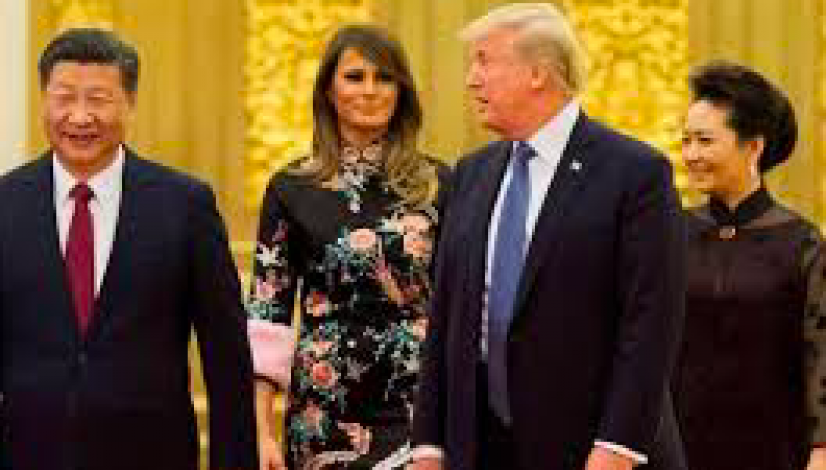Finally, a president willing to combat Chinese theft

Finally, we have a president willing to stand up to China and willing to confront the Chamber of Commerce crowd that has long been China’s best friend and enabler.
It was only a matter of time before President Trump ran smack into the big business interests that fund many in the Republican Party and that have been instrumental in the creation of trade agreements and the outsourcing of jobs that have wreaked havoc on American workers.
He has offended the corporate world by backing out of the Trans-Pacific Partnership (TPP), playing hardball with our North American Free Trade Agreement (NAFTA) partners and now, crucially, by confronting Beijing. It’s time someone did.
Just in the past three years, according to a report from the bipartisan IP Commission, the U.S. has suffered $1.2 trillion in economic damage from the theft of intellectual property, most of it orchestrated by China. The report notes, that the $1.2 trillion doesn’t include the estimated costs of wide-spread patent infringement.
U.S. businesses turned a blind eye to the thievery in hopes of selling into that country’s fast-growing consumer market or accessing China’s cheap labor. Despite official promises to curb the practice, China continues to illicitly harvest U.S. patents and know-how.
This past year, United States Trade Representative Robert Lighthizeroversaw a lengthy investigation into China’s intellectual property theft, which led the president to impose $60 billion of tariffs on Chinese goods. The probe determined that, “Chinese theft of American IP currently costs between $225 billion and $600 billion annually.”
CEOs of firms that have set up shop in China recount many ruses. In one, they build a factory with the mandated local partner, do brisk business for a year or so and then find their revenues mysteriously plunging.
A cursory investigation reveals that their local partner has duplicated the plant a few miles down the road, having acquired the necessary designs, and is quickly undercutting their joint venture. It’s an old game, but, repeated many times over, costly to American interests.
Of course, the Chinese are also prodigious counterfeiters, knocking off everything from Louis Vuitton handbags to Harley Davidsons and prescription medicines. But those are just the obvious ways the Chinese have stolen from the U.S.
It has also long been Beijing’s practice to demand that companies wishing to manufacture in the country share their technology; many U.S. firms were happy to oblige.
They have also thrown up obstacles galore to prevent companies from operating in China or imposed opaque penalties and restrictions on firms that are alleged to have misbehaved. In a country where business people are occasionally snatched off the street and disappear, the rule of law does not apply.
Since Beijing mastered the art of hacking, the stealing has become more widespread and sophisticated. Some is done by rogue agents, but much of the criminal activity is apparently sanctioned by Beijing.
The Chinese military is rumored to employ 100,000 hackers. Chinese hackers have invaded U.S. businesses, institutions, universities, power plants and nearly every other kind of U.S. organization.
Then there is old-fashioned spying. Earlier this year, a leading Chinese wind turbine maker, Sinovel, was found guilty by a jury in Wisconsin of stealing trade secrets. The prosecutor said the theft “nearly destroyed” AMSC, an American firm supplying technology critical to the manufacture of wind turbines.
In 2017, a dual citizen of China and Canada was accused of stealing trade secrets from Medrobotics, a Massachusetts company making robotic surgical products. Dong Liu was caught by the CEO transferring data onto his laptop.
Also last year, U.S. prosecutors revealed that Chinese nationals and their cybersecurity firm Boyusec hacked industrial giant Siemens, the economic analysis firm Moody’s and the GPS navigation company Trimble and stole secret company documents.
These examples are commonplace.
What did President Obama do in response to such outrages? Absolutely nothing. It wasn’t as though his administration didn’t know what was going on. The Office of the Director of National Intelligence in November 2015 reported that China’s hacking was costing U.S. companies $360 billion per year.
Obama was too intent on having Beijing sign on to his legacy Paris climate agreement, which was inked in 2016; he didn’t want to rock the boat. In that bogus pact, the U.S. vowed to cut back our already declining emissions, while China made no serious commitments, and in fact acted only in response to internal protests against the country’s foul air and water.
China’s carbon emissions are estimated to have jumped more than 3 percent last year, as the growth of coal consumption resumed, driving the world’s totals higher. No one knows for sure because authorities around the world doubt the veracity of the country’s reports. That’s who we are dealing with.
The U.S. is not the only country wising up to the costs of doing business with the Chinese. The U.K., Australia and France have all taken a tougher stance on China’s unfair trade practices, in some cases demanding new anti-dumping rules and also greater barriers to acquisitions of domestic companies.
French President Emmanuel Macron has said the West’s acquiescence to China’s approach is “naïve” and in a visit to Beijing earlier this year said the new Silk Road China is anxious to rebuild “cannot be one-way.”
Big business in the U.S. is understandably worried that Trump’s rebuff of China could backfire and that a trade war may result. But already it is clear that the president’s metals tariffs were a warning short across the bow and an opening bid; nearly half of aluminum and steel imports have been exempted until May.
Like the missiles launched against Syria during Xi Jinping’s first meeting with Trump at Mar-a-Lago, which heralded the follow-on elimination of ISIS, they sent a clear message. China should take the White House’s opposition to its trade cheating very, very seriously.
Published on The Hill




